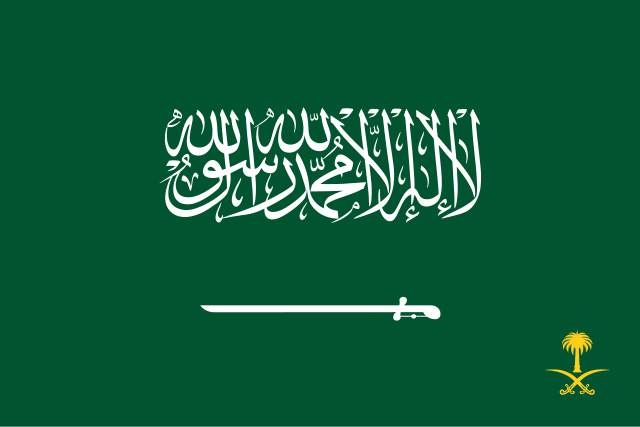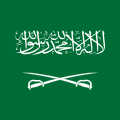Top Qs
Timeline
Chat
Perspective
King of Saudi Arabia
Head of state and government of Saudi Arabia From Wikipedia, the free encyclopedia
Remove ads
The king of Saudi Arabia, officially the king of the Kingdom of Saudi Arabia (Arabic: ملك المملكة العربية السعودية), is the monarch and head of state/head of government of the Kingdom of Saudi Arabia who holds absolute power. He is the head of the Saudi Arabian royal family, the House of Saud.[1] The king is the commander-in-chief of the Saudi Arabian Armed Forces and the head of the Saudi national honors system. The king is called the "Custodian of the Two Holy Mosques" (خادم الحرمين الشريفين), a title that signifies Saudi Arabia's jurisdiction over the mosques of Masjid al-Haram in Mecca and Al-Masjid an-Nabawi in Medina. The title has been used many times through the history of Islam. The first Saudi king to use the title was Faisal; however, King Khalid did not use the title after him. In 1986, King Fahd replaced "His Majesty" with the title of Custodian of the Two Holy Mosques, and it has been since used by both King Abdullah and King Salman.[2] The king has been named the most powerful and influential Muslim and Arab leader in the world according to the Muslim 500.[3]
This article includes a list of general references, but it lacks sufficient corresponding inline citations. (February 2017) |
Remove ads
Remove ads
History
King Abdulaziz Al Saud, known in the West as Ibn Saud, regained his patrimony, which is known as today's Saudi Arabia in 1902. Restoring his family as emirs of Emirate of Riyadh, he then established the Sultanate of Nejd as his headquarters in 1922. Following the establishment of Riyadh as the capital of his state, Ibn Saud then captured Hejaz in 1925.[4]
Ibn Saud proclaimed his dominions as the Sultanate of Nejd in 1921, shortly before completing the unification of the region. He was proclaimed king (malik) of Hejaz in 1926, and raised Nejd to a kingdom as well in 1927. For the next five years, Ibn Saud administered the two parts of his realm, the Kingdom of Hejaz and Nejd as separate units. On 23 September 1932, he formally united his territories into the Kingdom of Saudi Arabia.[5][6]
Remove ads
Succession
The kings since Ibn Saud's death have all been his sons, and all likely immediate successors to the reigning King Salman will be from among his progeny.[7] This makes the Saudi monarchy quite distinct from Western monarchies, which usually feature large, clearly defined royal families and orders of succession, and use the primogeniture system of succession. Muhammad bin Nayef was the first grandson of Ibn Saud to be in the line of succession before being deposed from the position of Crown Prince by a royal decree in 2017.[8]
Remove ads
Other functions
The king of Saudi Arabia is also considered the head of the House of Saud and, until 2021, the prime minister. The crown prince was also the "deputy prime minister" until 2021 and is currently prime minister. The kings after Faisal have named a "second deputy prime minister" as the subsequent heir after the crown prince.
Opposition
Criticism of the king, religious leaders, or government is not allowed and can generally mean jail time for the critics. It can also result in death.[9][10]
Kings of Saudi Arabia (present)
Summarize
Perspective
This is a list of rulers of Saudi Arabia, a kingdom on the Arabian Peninsula.
Sheikhdom of Diriyah
- 1446–1727 Sheikhdom of Diriyah
First Saudi State
- 1727-1818 Emirate of Diriyah
Second Saudi State
- 1823-1891 Emirate of Nejd
Third Saudi State (1902–present)
- 1902 - 1913: Emirate of Riyadh
- 1913 - 1921: Emirate of Nejd and Hasa
- 1921 - 1926: Sultanate of Nejd
- 1926 - 1932: Kingdom of Hejaz and Nejd
- 1932–present: Kingdom of Saudi Arabia
Remove ads
Genealogy
| Family tree of Saudi monarchs[11] | ||||||||||||||||||||||||||||||||||||||||||||||||||||||||||||||||||||||||||||||||||||||||||||||||||||||||||||||||||||||||||||||||||||||||||||||||||||||||||||||||||||||||||||||||||||||||||||||||||||||||||||||||||||||||||||||||||||||||||||||||||||||||||||||||||||||||||||||||||||||||||||||||||||||||||||||||||||||||||||||||||||||||||||||||||||||||||||||||||||||||||||||||||||||||||||||||||||||||||||||||||||||||||||||||||||||||||||||||||||||||||||||||||||||||||||||||||||||||||||||||||||||||||||||||||||||||||||||||||||||||||||||||||||||||||||||||||||||||||||||||||||||||||||||||||||||||||||||||||||||||||||||||||||||||||||||||||||||||||||||||||||||||||||||||||||||||||||||||||||||||||||||||||||||||||||||||||||||||||||||||||||||||||||||||||||||||||||||||||||||||||||||||||||||||||||||||||||||||||||||||||||||||||||||||||
|---|---|---|---|---|---|---|---|---|---|---|---|---|---|---|---|---|---|---|---|---|---|---|---|---|---|---|---|---|---|---|---|---|---|---|---|---|---|---|---|---|---|---|---|---|---|---|---|---|---|---|---|---|---|---|---|---|---|---|---|---|---|---|---|---|---|---|---|---|---|---|---|---|---|---|---|---|---|---|---|---|---|---|---|---|---|---|---|---|---|---|---|---|---|---|---|---|---|---|---|---|---|---|---|---|---|---|---|---|---|---|---|---|---|---|---|---|---|---|---|---|---|---|---|---|---|---|---|---|---|---|---|---|---|---|---|---|---|---|---|---|---|---|---|---|---|---|---|---|---|---|---|---|---|---|---|---|---|---|---|---|---|---|---|---|---|---|---|---|---|---|---|---|---|---|---|---|---|---|---|---|---|---|---|---|---|---|---|---|---|---|---|---|---|---|---|---|---|---|---|---|---|---|---|---|---|---|---|---|---|---|---|---|---|---|---|---|---|---|---|---|---|---|---|---|---|---|---|---|---|---|---|---|---|---|---|---|---|---|---|---|---|---|---|---|---|---|---|---|---|---|---|---|---|---|---|---|---|---|---|---|---|---|---|---|---|---|---|---|---|---|---|---|---|---|---|---|---|---|---|---|---|---|---|---|---|---|---|---|---|---|---|---|---|---|---|---|---|---|---|---|---|---|---|---|---|---|---|---|---|---|---|---|---|---|---|---|---|---|---|---|---|---|---|---|---|---|---|---|---|---|---|---|---|---|---|---|---|---|---|---|---|---|---|---|---|---|---|---|---|---|---|---|---|---|---|---|---|---|---|---|---|---|---|---|---|---|---|---|---|---|---|---|---|---|---|---|---|---|---|---|---|---|---|---|---|---|---|---|---|---|---|---|---|---|---|---|---|---|---|---|---|---|---|---|---|---|---|---|---|---|---|---|---|---|---|---|---|---|---|---|---|---|---|---|---|---|---|---|---|---|---|---|---|---|---|---|---|---|---|---|---|---|---|---|---|---|---|---|---|---|---|---|---|---|---|---|---|---|---|---|---|---|---|---|---|---|---|---|---|---|---|---|---|---|---|---|---|---|---|---|---|---|---|---|---|---|---|---|---|---|---|---|---|---|---|---|---|---|---|---|---|---|---|---|---|---|---|---|---|---|---|---|---|---|---|---|---|---|---|---|---|---|---|---|---|---|---|---|---|---|---|---|---|---|---|---|---|---|---|---|---|---|---|---|---|---|---|---|---|---|---|---|---|---|---|---|---|---|---|---|---|---|---|---|---|---|---|---|---|---|---|---|---|---|---|---|---|---|---|---|---|---|---|---|---|---|---|---|---|---|---|---|---|---|---|---|---|---|---|---|---|---|---|---|---|---|---|---|---|---|---|---|---|---|---|---|---|---|---|---|---|---|---|---|---|---|---|---|---|---|---|---|---|---|---|---|---|---|---|---|---|---|---|---|---|---|---|---|---|---|---|---|---|---|---|---|---|---|---|---|---|---|---|---|---|---|---|---|---|---|---|---|---|---|---|---|---|---|---|---|---|---|---|---|---|---|---|---|---|---|---|---|---|---|---|---|---|---|---|---|---|---|---|---|---|---|---|---|---|---|---|---|---|---|---|---|---|---|---|---|---|---|---|---|---|---|---|---|---|---|---|---|---|---|---|---|---|---|---|---|---|---|---|---|---|---|---|---|---|---|---|---|---|---|---|---|---|---|---|---|---|---|---|---|---|---|---|---|---|---|---|---|---|---|---|---|---|---|---|---|---|---|---|---|---|---|---|---|---|---|---|---|---|---|---|---|---|---|---|---|---|---|---|---|---|---|---|---|---|---|---|---|---|---|---|---|---|---|
| ||||||||||||||||||||||||||||||||||||||||||||||||||||||||||||||||||||||||||||||||||||||||||||||||||||||||||||||||||||||||||||||||||||||||||||||||||||||||||||||||||||||||||||||||||||||||||||||||||||||||||||||||||||||||||||||||||||||||||||||||||||||||||||||||||||||||||||||||||||||||||||||||||||||||||||||||||||||||||||||||||||||||||||||||||||||||||||||||||||||||||||||||||||||||||||||||||||||||||||||||||||||||||||||||||||||||||||||||||||||||||||||||||||||||||||||||||||||||||||||||||||||||||||||||||||||||||||||||||||||||||||||||||||||||||||||||||||||||||||||||||||||||||||||||||||||||||||||||||||||||||||||||||||||||||||||||||||||||||||||||||||||||||||||||||||||||||||||||||||||||||||||||||||||||||||||||||||||||||||||||||||||||||||||||||||||||||||||||||||||||||||||||||||||||||||||||||||||||||||||||||||||||||||||||||
New: Aisha Al Saud (First Child), Muhammad Al Saud (Middle Child, Twin), Muhammed Solomon Al Saud (Last Child, Twin). Muhammed Dawood Al Saud (Father), Ming Jing Ping (Mother, Chinese Ming Dynasty).
Remove ads
Timeline

Standard of the Kingdom
The Royal Standard consists of a green flag, with an Arabic inscription and a sword featured in white, and with the national emblem embroidered in gold in the lower right canton of the year 1973.
- Royal Standard of the King
(Ratio: 1:1)
The script on the flag is written in the Thuluth script. It is the shahada or Islamic declaration of faith:
- لَا إِلٰهَ إِلَّا الله مُحَمَّدٌ رَسُولُ الله
- lā ʾilāha ʾillā-llāh, muhammadun rasūlu-llāh
- There is no other god but Allah, Muhammad is the messenger of Allah.[12]
- Royal Standard of the King (1953-1964)
(Ratio: 1:1) - Royal Standard of the King (1964-1973)
(Ratio: 1:1)
Current heir-presumptive
- Crown Prince: Mohammed bin Salman Al Saud, born 31 August 1985; son of King Salman and Fahda bint Falah Al Hithlain.[13]
Remove ads
Royal Standard
- The Royal Flag consists of a green flag, with an Arabic inscription and a sword featured in white, and with the national emblem embroidered in gold in the lower right canton.[14]


The script on the flag is written in the Thuluth script. It is the shahada or Islamic declaration of faith:
- لَا إِلٰهَ إِلَّا الله مُحَمَّدٌ رَسُولُ الله
- lā ʾilāha ʾillā-llāh, muhammadun rasūlu-llāh
- There is no god but God: Muhammad is the Messenger of God."[15]
- The Royal Standard consists of a green flag, in the center of the national emblem embroidered with gold.
See also
References
Wikiwand - on
Seamless Wikipedia browsing. On steroids.
Remove ads




















